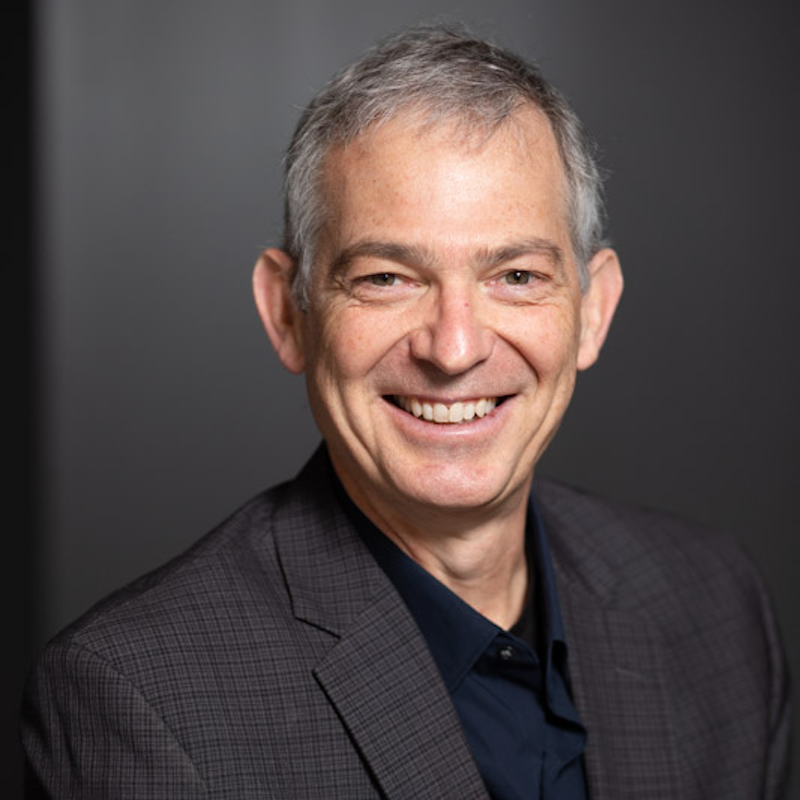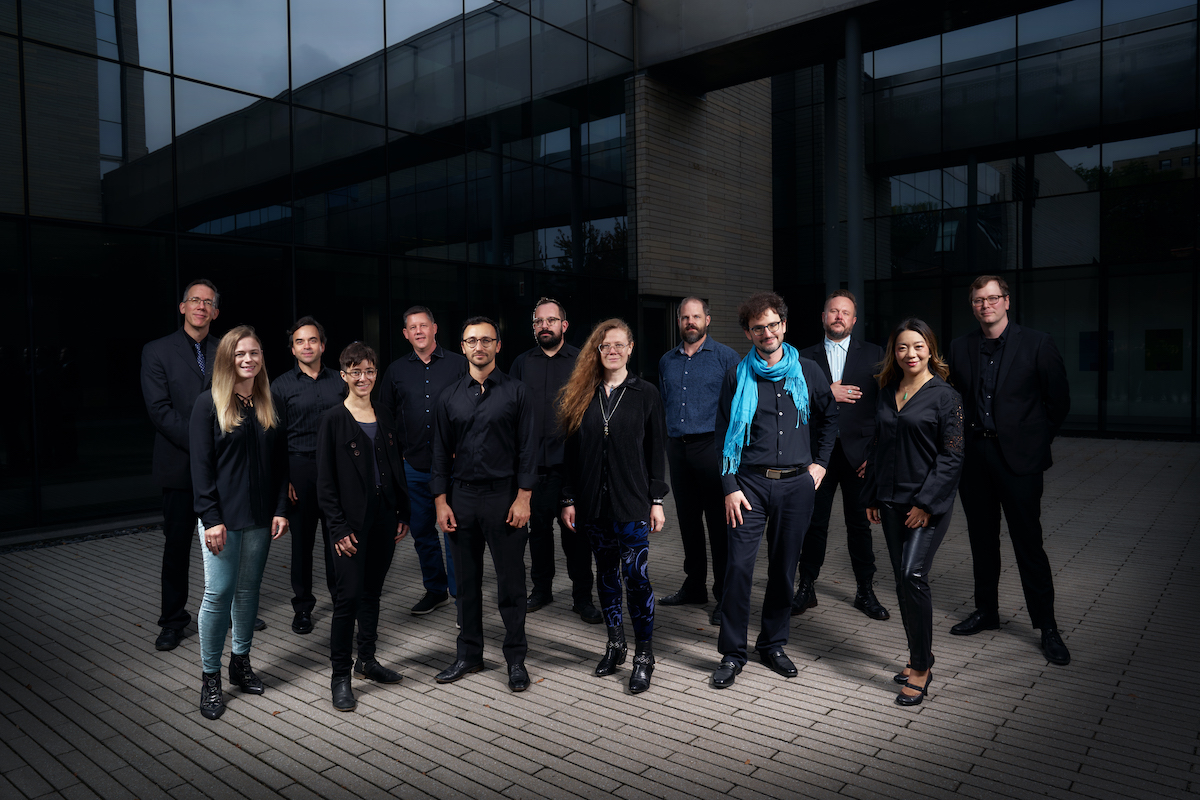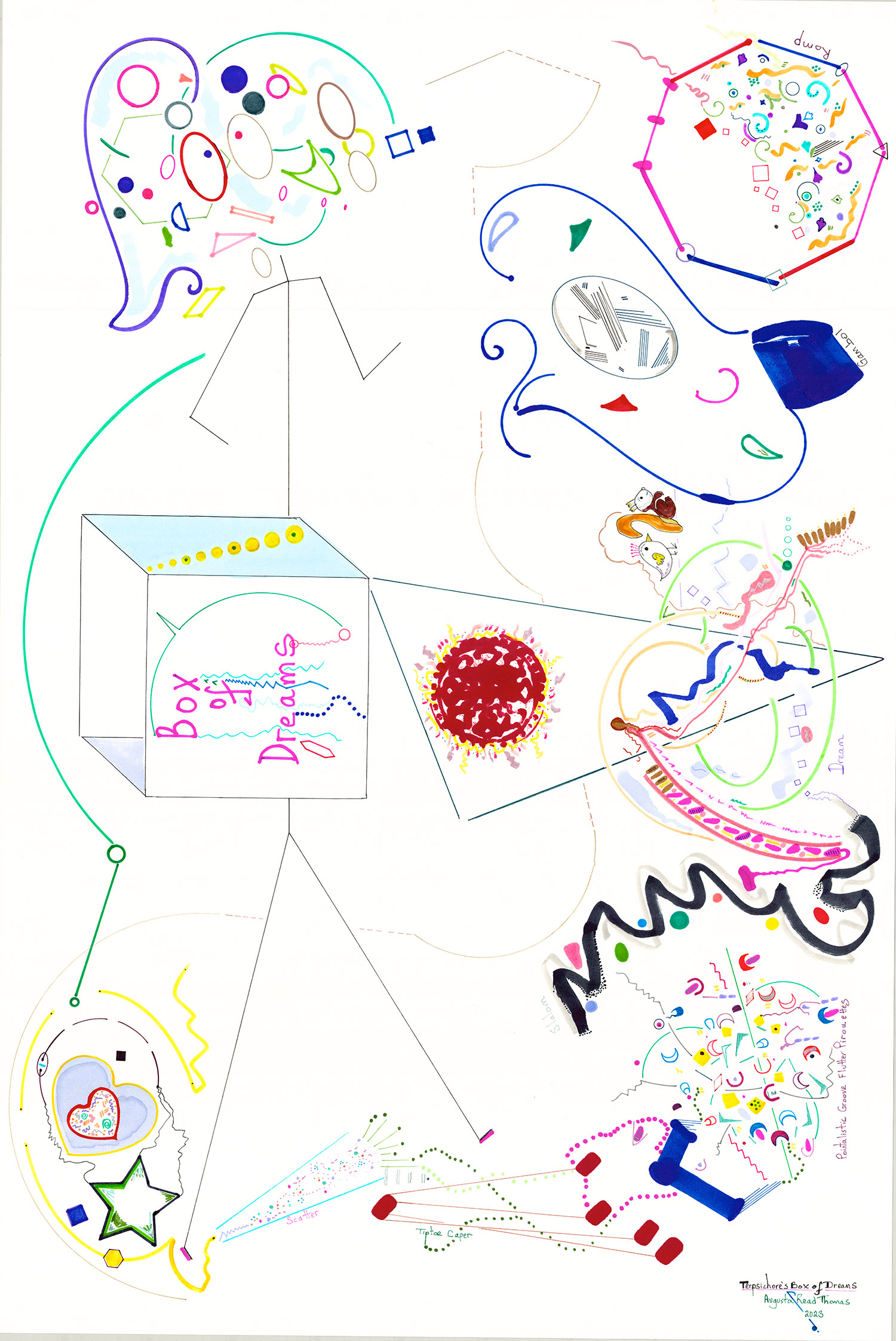Fl. (picc.), Ob., Cl. (bass cl.), Alto saxophone (baritone sax.*), Hn, 2 Perc., Hp, Pno., 2 VL, VA, and VC. (Or, instead of single strings: 33330)
*In the case where Saxophone is not available, a second Clarinet (bass cl.) player can replace the Saxophone (baritone sax.). There is only one score and set of parts which incorporates all versions. For example, in the individual parts, whenever there is a saxophone cue it is marked "Sax. (or Cl. 2)” In the set of parts from the publisher, Sax/cl 2 parts are labeled as parts #04a & #04b.
First performance by the Grossman Ensemble conducted by Timothy Weiss on 19 May 2023 in the performance hall of the Reva and David Logan Center for the Arts at the University of Chicago as presented by the Chicago Center for Contemporary Composition
UK premiere by the London Sinfonietta conducted by Vimbayi Kaziboni on 25 May 2023 at Southbank Centre's Queen Elizabeth Hall, London.
Duration: 19 minutes
Dedicated with admiration and gratitude to Dr. and Mrs. Grossman, the Grossman Ensemble, and Timothy Weiss.
Composed between January 16, 2023 and February 22, 2023
The Grossman Ensemble, conducted by Timothy Weiss - world premiere of Terpsichore's Box of Dreams
"The future has an ancient heart."
— Carlo Levi
"This is music that is always in motion, as if coming perpetually out of a magician’s hat. It leads but doesn’t direct, and is playful and subtle, dancing on light feet. It is music that conjures."
— Huffington Post
Music for me is an embrace of the world, a way to open myself to being alive in the world--in my body, in my sounds, and in my mind. I care deeply about musicality, imagination, craft, clarity, dimensionality, an elegant balance between material and form, and empathy with the performing musicians as well as everyone who works in the presenting organizations.
I have placed a quote by Carlo Levi at the top of the first page of this new composition: “The future has an ancient heart.” Leaping to my ear and mind is the related idea that the ancient has a future heart.
In ancient Greek mythology, the muse Terpsichore, a daughter of Zeus and Mnemosyne, is the goddess of dance and delight. With her in mind, I have sought to sculpt music that allows our individual and collective creative work to turn freely in the air. Terpsichore’s Box of Dreams is by turns lively, sprightly, spry, energetic, vigorous; it is animated, traveling, flexible, versatile, changing, fluid, and buoyant. While this is not exactly a “concerto for ensemble,” each of the thirteen musicians is featured in several soloistic, virtuosic passages. What will pop out of Terpsichore’s box next?
Although my music is meticulously notated in every detail, I like it to sound like it was being spontaneously invented. It is always in the act of becoming. I have a vivid sense that the process of the creative journey (rather than a predictable fixed point of arrival) is, for me, essential.
I dance while I compose, hoping that my music will feel organic and self-propelled. I work hard to ensure that my music too dances; I often create in my mind and ear imaginary flexible dances and ballets, poems, visual art, lighting, or animations, and I love virtuosic performances that percolate and spiral with natural musicality. My music must be alive, jumping off the page and out of the instrument as if something big is at stake.
This composition, which starts with Terpsichore’s entrance and ends with her departure, imagines the magic box that contains many things, including seven varied, colorful, dimensional dances: 1, Scatter; 2, Tiptoe Caper; 3, Pointillistic Groove Flutter Pirouettes; 4, Slalom; 5, Dream; 6, Gambol; 7, Romp. The form is a crescendo of instrumental expertise: throughout the seventeen-minute composition the brief dances become progressively more virtuosic. The longest dance is no. 5, Dream, which begins at the midpoint of the composition. Elegant, lyrical, and resonant, it concludes with an awakening-from-the-slumber-of-dream at sunrise, with morning birds and running squirrels. Suddenly the sixth dance, Gambol, swirls forward. After a fifty-second interlude featuring solo violin, oboe, and clarinet, it leads to the irreversible escapade that is dance no. 7, Romp.
Organic and at every level concerned with transformations and connections, the carefully sculpted and fashioned musical materials are agile and spirited. Their flexibility allows pathways to braid harmonic, rhythmic, timbral, and contrapuntal elements which are constantly transformed--sometimes whimsical and light, sometimes jazzy, sometimes almost balletic, sometimes vaguely akin to lively and spirited music on a caffeine rush, sometimes layered and reverberating with overtly cantabile, melodic resonance, pirouettes, fulcrum points, and effervescence.
Terpsichore’s Box of Dreams unfolds a labyrinth of musical interrelationships and connections that showcase the thirteen world-class musicians of the Grossman Ensemble. Here is a virtuosic display of rhythmic and timbral dexterity, counterpoint, skill, energy, dynamic and articulative range, precision, and teamwork. When feasible the composition is to be performed with dancers.
Collaborating with the Grossman Ensemble and Tim Weiss has been one of the most exhilarating experiences of my creative life. It is difficult to express how grateful I am to the many extraordinary colleagues who have made this relationship possible.
Music’s eternal quality is its capacity for change, transformation, and renewal. No one composer, musical style, school of thought, technical practice, or historical period can claim a monopoly on music’s truths. I believe music feeds our souls. Unbreakable is the power of art to build community. Humanity has and will always work together to further music’s flexible, diverse capacity and innate power.
PROGRAM BOOK LISTING
Please note that for any concert performance, the program book and all publicity must include the commission credit and the dedication lines as well as the names of collaborators:
The Grossman Ensemble conducted by Timothy Weiss.
Terpsichore's Box of Dreams (2023) Augusta Read Thomas (b. 1964)
TERPSICHORE ENTERS
Vibrant and radiant
DANCE #1: SCATTER
Energized and vivid
DANCE #2: TIPTOE CAPER
Playful, with groove, and contrapuntal
DANCE #3: POINTILLISTIC GROOVE FLUTTER PIROUETTES
Frizzante and vivacious
DANCE #4: SLALOM
Energetic and dynamic
DANCE #5: DREAM
Elegant and lyrical
TRANSITION (optional)
– awaking-from-the-slumber-of-dream – sunrise, morning birds and running squirrels
DANCE #6: GAMBOL
Animated, optimistic and spirited
DANCE #7: ROMP
Sparkling frolics with groove
TERPSICHORE DEPARTS
Ardent and glistening


Jeff Rosenfeld, San Francisco Classical Voice December 4, 2024
“Throughout, San Francisco Chamber Music Players’ musicians played as if their lives depended on it, demolishing any misapprehensions one might have about new music being too academic. These were colorful pieces that astonished not only ears and eyes but our sense of human capabilities.
For example, in the West Coast premiere of Augusta Read Thomas’s Terpsichore’s Box of Dreams (2023), the ensemble, under Artistic Director Eric Dudley, played precisely, confidently, and with a range emotions, delighting in the micro-rhythms and micro-melodies of Thomas’s pointillistic tour-de-force. Danceable and flowing lines emerged, with surprises at every turn. I could call out literally every member of the ensemble in this concerto for 13 virtuosos, a showpiece as dazzling as any in the repertoire.”
BBC Music Magazine, Recording Of The Month, May 2024
A BOX OF RESPLENDENT MUSICAL TREASURES
Kate Wakeling basks in the glow of this shimmering collection of recent works featuring The Grossman Ensemble.
"The selection nonetheless showcases the breadth of her composition, both in its varied sonorities and creative subject matter. Terpsichore’s Box of Dreams (2023) for chamber ensemble is the album’s most substantial work. Devised as a sequence of seven dances, the piece explores the sensibilities of the muse Terpsichore, ‘goddess of dance and delight’, and imagines her ‘box of dreams’, out of which tumble a ‘kaleidoscopic profusion [of] ideas and colours’. It is a remarkable score: mercurial in its wit and beauty with moments of shimmering poignancy (the third dance also receives this top-notch title: ‘Pointillistic Groove Flutter Pirouettes’) and it here receives an aptly pliant and sparky reading from the Grossman Ensemble under Tim Weiss."
Louis Harris, Third Coast Review May 21, 2023
"The concert concluded with a world premiere by a Chicago-based composer, Augusta Read Thomas. Terpsichore’s Box of Dreams is a wonderful suite of 10 movements based on the goddess of dance and delight from Greek mythology, a regular source of inspiration for Thomas’ music.
In keeping with Terpsichore’s character, the piece is very fun and energetic with lots of moving parts. In explaining the piece, Thomas noted how it could be choreographed for dance, and several movements are labeled as dances. Dance-like tempos and rhythms pervade the work.
It also showcases Thomas’ penchant for finding interesting musical motifs and rhythmic phrases that she manipulates in all kinds of ways. Sometimes the melodies are passed between the instruments, at other times the instruments come together to play in unison. Thomas also included lower pitched winds in the score.
While Thomas described it as a suite, it comes across more as a set of variations, with the rhythm shifting with the changes in the dance, from “Dance #1: Scatter” to “Dance #2: Tiptoe Caper” to “Dance #3: Pointillistic Groove Flutter pirouettes”, etc. At the center things slow down for a dream sequence with a marvelous aural tapestry, before a sunrise transition speeds back up to “Dance #6: Gambol.” Terpsichore’s Box of Dreams was a fun way to end an enjoyable evening."
M.L. Rantala, Classical Music Critic, Hyde Park Herald, May 24, 2023
"The concert closed with an utterly delightful new work by Augusta Read Thomas, the guiding light at the CCCC. “Terpsichore’s Box of Dreams” honors the goddess of dance and delight with a series of seven short dances plus an introduction (“Terpsichore Enters”) and conclusion (“Terpsichore Departs”).
In her pre-performance remarks, she described the work as containing a “kaleidoscope of color” and offered her own little bebop phrase to explain some of the energetic movement of the work.
The music grabbed you from the start, with a jazzy bongo beat and singing sound from the ensemble’s top voices. The dances had names like “Scatter” where the music really did seem to scurry in all directions yet still had clear cohesion. “Dream” had a gauzy effect and some of the most gorgeous music of the entire suite, notably from the oboe. (I asked oboist Andrew Nogal about performing this piece and he said that while rehearsing at home even after he had mastered parts of the score he would stop and play parts again simply because they were so beautiful.)
Thomas’s music exuded joy and optimism, vivacious movement, and spirited exclamations. This piece will receive its United Kingdom premiere soon, but I don’t think the London Sinfonietta will be able to outdo the magnificent performance of the Grossman Ensemble. When it was over, the audience applauded and whistled. There were hoots and hollers. They loved it.
During the reception that followed, I asked Professor Thomas how she felt about the ensemble’s performance of her work. “I feel humbled and grateful making new art together with the Grossman Ensemble, with their precision and eloquence."



Special thanks to donors and supporters of the Chicago Center for Contemporary Composition: Carolyn (Kay) Bucksbaum, Emmanuel Roman, Gay K. Stanek, the Sanford J. Grossman Charitable Trust, and other generous supporters





To obtain examination or performance material for this
Augusta Read Thomas work, please contact Nimbus Music Publishing.
